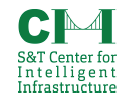Webinar Date
29 Apr 2022, 10:00 am
Abstract
Structural health monitoring (SHM) is a critical means of assessing the performance of aging civil infrastructure. Earlier studies used heavy dynamic shakers to assess the dynamics of structures, which are unwieldy and reliance has been shifted to ambient vibration of structures to extract dynamic features. This study introduces a “virtual shaker” concept that effectively replaces the physical shaker and provides all the desired features for SHM. Examples are provided along with an App that facilitates the use of this concept to identify dynamic features. A traditional structural health monitoring (SHM) operation requires a wired system, which is often termed “hub and spoke” because the sensors are located throughout the structure and then wired to a central data acquisition server. To avoid issues associated with long cables, a unique prototype system in SHM, SmartSync, an “IoT”, with “edge computing,” which utilizes the building's existing Internet backbone as a system of “virtual” instrumentation cables and limited computations at the sensor location has been developed. Since the system is modular and largely “plug-and-play”, the units can be rapidly deployed at any location with access to power and an Internet connection and has been implemented in the Burj Khalifa, the tallest building in the world. For rural footbridges remotely located, the citizen sensing approach has been used to monitor their response in storms and to identify their dynamic feature. An example from Nicaragua will be presented. In an age of unprecedented sensing technology that allows for greater volumes of climate and infrastructure-related data to be collected and analyzed places a new demand. This proliferation of data has led to building data-driven models to better assess our infrastructure and implement solutions oriented towards sustainability and resiliency. The seminar will address new developments in system identification involving non-stationary observations and their real-time monitoring. Machine learning is becoming ubiquitous in this context and is enabling data-to-model and automated feature extraction from SHM observations. The use of various machine learning schemes embedded with Hilbert, Wavelet and Shapelet transforms will be presented with examples from Burj Khalifa, Sutong Yangtze River Bridge and the European Union’s surface wind monitoring in the Port of Genoa, Italy.
Biography
Ahsan Kareem is the Robert M. Moran Professor of Engineering and the Director of the NatHaz Modeling Laboratory at the University of Notre Dame. His work focuses on probabilistic characterization and formulation of dynamic load effects due to wind, waves and earthquakes on tall buildings, long-span bridges, offshore structures and other structures, via fundamental experimental, laboratory and full-scale measurements utilizing cyber and cyber-physical infrastructures, for their safety assessment and mitigation measure.
He is elected President of the International Association for Wind Engineering (IAWE). He has been awarded numerous honors, including the inaugural Presidential Young Investigator Award from the White House. A recipient of ASCE’s: Theodore von Karman Medal, Nathan Newmark Medal, Masanobu Shinozuka Medal, James Croes Medal, Earnest Howard Medal, Robert H. Scanlan Medal and Jack E. Cermak Medal and State-of-the-Art Award, inducted to the Offshore Technology Conference Hall of Fame and Distinguished Member of ASCE; Alan G. Davenport Medal of IAWE; Distinguished Research Award of IASSAR (Int’l Assoc. for Structural. Safety and Reliability); delivered 2013 Scruton Lecturer at the Institute of Civil Engineers, London. He has been appointed Honorary Professor at several universities overseas including Tsinghua and Tongji in PROC. He serves on the Editorial Board of several international journals and has recently co-authored three books. He is an elected member of the US National Academy of Engineering and a foreign member of the Indian, Chinese and Japanese Academies of Engineering.
Recommended Citation
Kareem, Ahsan, "Structural Health Monitoring: From Virtual Shakers to Machine Learning" (2022). Abbett Distinguished Seminar Series. 4.
https://scholarsmine.mst.edu/cii-lectures/4
Department(s)
Civil, Architectural and Environmental Engineering
Research Center/Lab(s)
Center for Intelligent Infrastructure
Document Type
Presentation
Document Version
Final Version
File Type
movingimage
Language(s)
English
Rights
© Missouri University of Science and Technology, All rights reserved.



